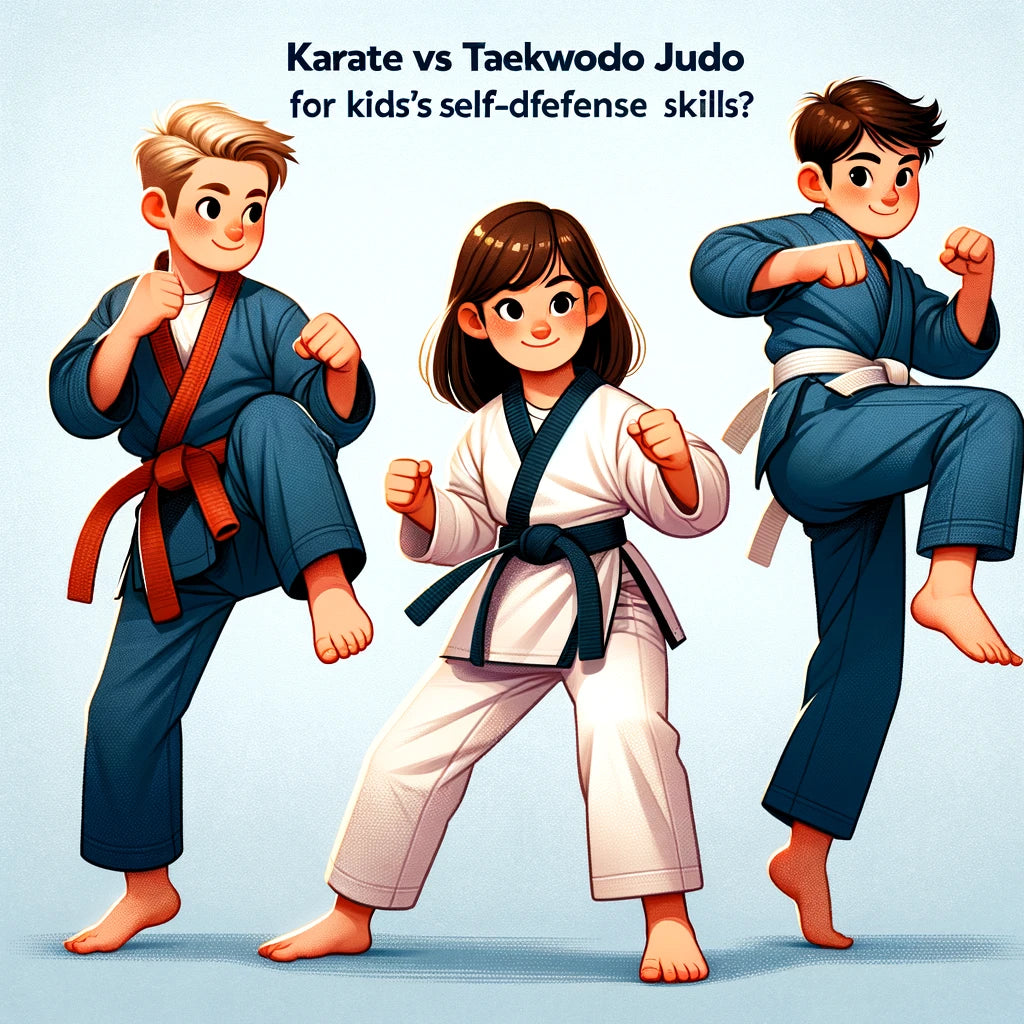
Karate vs Taekwondo vs Judo: Which is Best for Kids' Self-Defense Skills
March 08, 2024 4 min read
As a parent, you naturally want to do everything to keep your child safe. Enrolling them in a martial arts class can give them the skills and confidence they need to protect themselves. This raises the question, which martial art is best for teaching kids self-defense?
Let's look at three of the most popular options – Karate, Taekwondo, and Judo – and explore their strengths in this area.
Karate: A Balance of Strikes and Blocks
Karate is a Japanese martial art that emphasizes striking techniques. Kids learn various punches, kicks, blocks, and open-handed strikes. Karate's focus on striking makes it a good choice for kids who want to learn how to defend against punches and kicks, and deliver these techniques if needed.
Advantages of Karate for Self-Defense
- Teaches Full-Body Defense: Children learn to defend all parts of their body effectively.
- Distance Management: Karate helps kids learn to control the distance of an encounter and stay out of reach of an aggressor.
- Discipline and Respect: Karate classes often emphasize discipline and respect for oneself and others, qualities that can help kids avoid trouble and de-escalate situations.
Taekwondo: The Power of Kicking
Taekwondo is a Korean martial art that emphasizes kicking. Students learn an impressive repertoire of kicks, including spinning kicks, jumping kicks, and multiple kick combinations. This emphasis on powerful leg techniques makes Taekwondo an attractive option for kids who want to develop strong and intimidating self-defense abilities.
Advantages of Taekwondo for Self-Defense
- Strong Legs, Strong Defense: Powerful kicks give kids stopping power to deter attackers.
- Creates Distance: Kicking techniques excel at keeping a potential attacker at bay.
- Fitness and Agility: Taekwondo builds excellent overall fitness, agility, and flexibility which are beneficial in any physical confrontation.
Judo: Throws, Takedowns, and Ground Control
Judo is a Japanese martial art that is built around throws, takedowns, and grappling techniques. Students learn to unbalance an opponent, bring them to the ground, and control them with pins, joint locks, and chokes. Judo emphasizes using the opponent's own momentum against them.
Advantages of Judo for Self-Defense
- Neutralizing Larger Opponents: Judo is excellent for smaller kids dealing with larger opponents, as it uses technique rather than relying on size.
- Close Quarters Mastery: Kids learn how to defend themselves at close range, including how to escape holds and grabs.
- Throws and Takedowns: Can stop an attacker in their tracks and allow the child to control the situation.
Is There a “Best” Martial Art for Self-Defense?
There is no best martial art for every child when it comes to self-defense. The choice of Karate, Taekwondo, or Judo depends on the child's personality, physical build, and interests.
Factors to Consider When Choosing a Martial Art for Kids
- Child's Personality: Does the child prefer striking, kicking, or grappling? Some have natural preferences.
- Goals and Focus: Does the child want well-rounded training or a focus on specific techniques?
- School Philosophy: It's crucial to find a good martial arts school. Visit a few classes like a karate class for kids in Ellicott City M.D. to observe the instructors and atmosphere.
The Benefits of Martial Arts Beyond Self-Defense
While self-defense might be the immediate concern for parents, martial arts offer much more for a child's development:
- Confidence and Self-Esteem
- Respect and Discipline
- Physical Fitness and Coordination
- Goal Setting and Mental Focus
No matter whether your child is drawn to the punches and forms of Karate, the exciting kicks of Taekwondo, or the throws and grappling of Judo, exploring martial arts is a positive investment in their physical and emotional well-being.
Self-Defense Goes Beyond Technique
While the technical aspects of a martial art are essential, self-defense for kids involves much more than just knowing moves.
Situational Awareness for Kids
One of the most critical self-defense skills is situational awareness. This means teaching children to:
- Be aware of their surroundings: Encourage them to pay attention to who and what is around them and to notice potential risks.
- Trust their instincts: If something feels wrong or unsafe, emphasize that it's okay to walk away, even if they seem like they're being rude.
- Avoid dangerous situations: Discuss risky behaviors, like walking alone in isolated areas or at night.
The Power of a Strong Voice
A strong, firm voice can be a valuable tool in fending off a potential attacker. Help your child practice:
- Yelling "NO!" forcefully: This can startle someone intending to do harm and attract the attention of others.
- Using Direct Commands: Teach them phrases like "Leave me alone!" or "Stay away from me!"
- Projecting Confidence: Even if feeling scared, encourage a strong posture and loud voice, which can make an attacker less likely to engage.
Real-World Scenarios and Role-Playing
For kids to truly internalize self-defense lessons, they need practice beyond the dojo.
- Discuss "What If" Scenarios: Talk through situations like being approached by a stranger, or getting bullied. Discuss potential responses.
- Role-Play: Act out different scenarios with your child, letting them practice their verbal and physical self-defense skills. Start with simple situations and gradually increase the complexity.
- Age-Appropriate Conversations: Be honest with your child about the potential dangers they could encounter, adjusting the information based on their age and maturity.
Finding the Right School
Choosing the right martial arts school is as important as the chosen art itself. Look for:
- Qualified Instructors: Do the instructors have recognized certifications and experience with teaching children?
- Positive Atmosphere: Does the school foster mutual respect, discipline, and a supportive learning environment?
- Safety Focus: Does the school emphasize safe training practices and injury prevention?
- Age-Appropriate Classes: Are the classes designed specifically for your child's age group and skill level?
A Lifelong Journey
Learning self-defense is not a one-time event; it's an ongoing process. Martial arts can be a fantastic gateway into self-defense, but even after your child starts classes, it's vital to:
- Continue Conversations: Regularly discuss safety issues and reinforce the lessons they learn in class.
- Encourage Practice: Help them practice techniques at home.
- Praise Their Efforts: Acknowledge their dedication to self-improvement and celebrate their progress.
Self-Defense is a Journey: How Martial Arts Can Guide Your Child
By empowering your child with the skills, mindset, and practical knowledge offered by martial arts and open communication, you'll be giving them a tremendous gift. While there's no single "best" style for every child, any of the paths explored in this article can help your child build confidence, strength, and the ability to protect themselves if needed.
Martial Arts for Children & Adults
SIGN UP FOR FREE LESSON
No Experience Necessary
